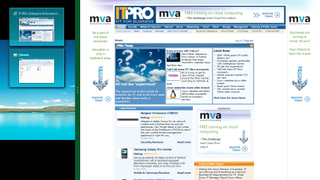Microsoft Windows 8 review: First Look
Windows 8 aims to combine a touchscreen Windows Phone 7-style interface with a traditional full-power desktop. Mary Branscombe gets hands on to see if it’s a winning combination.
The Windows 8 developer preview Microsoft is showing off at the BUILD conference in California isn't advanced enough to be beta code, but it does show off the new touch interface, which uses the Metro theme from Windows Phone 7, as well as a host of new desktop features. Although Microsoft has announced plans to port Windows to ARM processors, we only saw the x86 and 64-bit version of Windows 8 as ARM hardware isn't ready yet and there are no details of price, launch date or different Windows editions.
What we do get is the Windows 8 experience. The Start menu is replaced by the tile-based Start screen which is designed for touch but does work well with a mouse or even the arrow keys if you don't mind moving more slowly. That's the view you stay in as long as you only run the new Metro apps. These can be written in XAML languages, such as C# and Silverlight, or in HTML 5, CSS and JavaScript. Metro apps must also use the new APIs for sharing content with other apps, searching inside apps, pulling data from sensors such as GPS receivers and getting access to the file system.

The Metro interface for the Start screen; swipe at the side to open the charms' for searching, sharing and managing devices and settings.
On the demonstration hardware we saw, the gestures in both the Start screen and the traditional desktop felt smooth, fluid and easy to work with. In the Metro view of Internet Explorer 10 swiping in from the top or bottom gives you access to the tabs and the address bar, with the option to open in the desktop view to access settings. This is the third platform preview of IE 10 and it's still beta code, but the hardware acceleration makes it a fast browser, standards support looks good and it still supports familiar plug-ins such as Flash and Silverlight.

Browse Web pages in the touch interface or on the desktop for the full IE browser interface.
Get the ITPro. daily newsletter
Receive our latest news, industry updates, featured resources and more. Sign up today to receive our FREE report on AI cyber crime & security - newly updated for 2024.
Mary is a freelance business technology journalist who has written for the likes of ITPro, CIO, ZDNet, TechRepublic, The New Stack, The Register, and many other online titles, as well as national publications like the Guardian and Financial Times. She has also held editor positions at AOL’s online technology channel, PC Plus, IT Expert, and Program Now. In her career spanning more than three decades, the Oxford University-educated journalist has seen and covered the development of the technology industry through many of its most significant stages.
Mary has experience in almost all areas of technology but specialises in all things Microsoft and has written two books on Windows 8. She also has extensive expertise in consumer hardware and cloud services - mobile phones to mainframes. Aside from reporting on the latest technology news and trends, and developing whitepapers for a range of industry clients, Mary also writes short technology mysteries and publishes them through Amazon.





